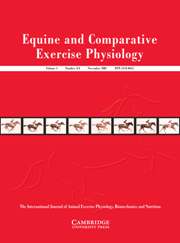Article contents
Effects of different bits and bridles on frequency of induced swallowing in cantering horses
Published online by Cambridge University Press: 09 March 2007
Abstract
It has been suggested that the presence of a bit reflexly increases salivation but, at the same time, interferes with the horse's ability to swallow. The objective of this study was to compare swallowing frequency in 12 horses exercising at canter while wearing a head collar, a bitless bridle, a jointed snaffle bit and a Myler correctional-ported barrel bit. Laryngeal movements were recorded videoendoscopically as the horses cantered (8 m s−1) on a high speed treadmill, with the use of side reins to flex the poll. Swallowing was stimulated artificially by infusion of sterile water at a constant rate of 5 ml min−1 through a cannula in the endoscope's biopsy port. The results showed large differences in swallowing frequency between horses. Swallowing frequency was lower for the Myler snaffle than for the other conditions (P<0.05). It is concluded that the presence of a bit does not preclude swallowing during exercise at canter with the poll in a flexed position, but certain types of bits may be associated with a reduction in swallowing frequency.
Information
- Type
- Research Article
- Information
- Copyright
- Copyright © Cambridge University Press 2005
References
- 10
- Cited by

